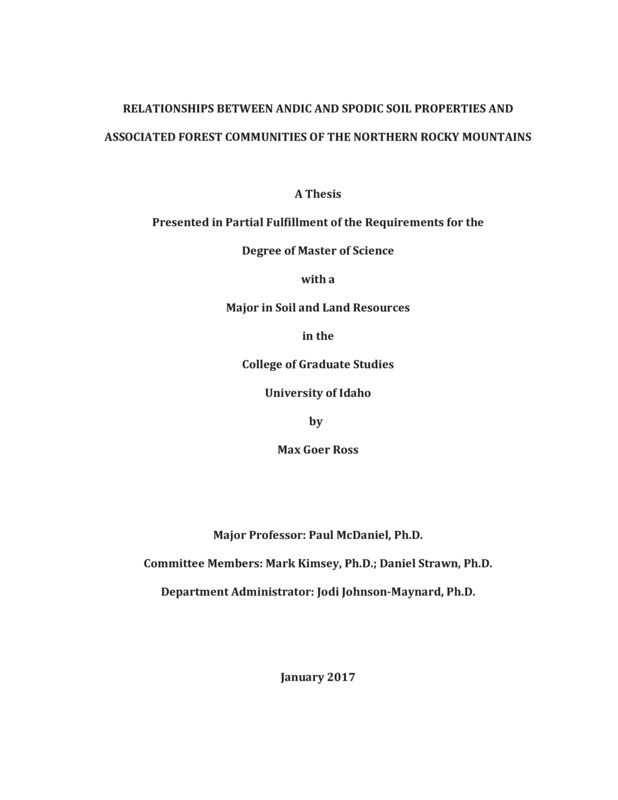RELATIONSHIPS BETWEEN ANDIC AND SPODIC SOIL PROPERTIES AND ASSOCIATED FOREST COMMUNITIES OF THE NORTHERN ROCKY MOUNTAINS
Ross, Max Goer. (2017). RELATIONSHIPS BETWEEN ANDIC AND SPODIC SOIL PROPERTIES AND ASSOCIATED FOREST COMMUNITIES OF THE NORTHERN ROCKY MOUNTAINS. Theses and Dissertations Collection, University of Idaho Library Digital Collections. https://www.lib.uidaho.edu/digital/etd/items/ross_idaho_0089n_11070.html
- Title:
- RELATIONSHIPS BETWEEN ANDIC AND SPODIC SOIL PROPERTIES AND ASSOCIATED FOREST COMMUNITIES OF THE NORTHERN ROCKY MOUNTAINS
- Author:
- Ross, Max Goer
- Date:
- 2017
- Keywords:
- Andisol forest type habitat type Northern Rocky Mountains Spodic intergrade Spodosol
- Program:
- Plant, Soil and Entomological Sciences
- Subject Category:
- Soil sciences; Ecology; Forestry
- Abstract:
-
Andisols, Spodosols, and Spodic intergrades are the dominant soils in the steep, volcanic ash-mantled forested terrain of the Northern Rocky Mountain region. The objective of this study was to look at pH, exchangeable Al, and organic carbon distributions in these three soil types as well as the relationships between these soil types and the structure of the forest communities they support across 44 sites in northern Idaho. Results demonstrate that Andisols and Spodosols possess significantly different morphological and chemical properties, and support distinctly different forest communities. Eluvial E horizons of Spodosols exhibit the lowest pH values (3.2) and greatest concentrations of exchangeable Al (8.4 cmolc/kg) of all soils, while Andisols have significantly higher pH and lower concentrations of exchangeable Al. Spodic intergrades have chemical properties similar to Spodosols, but support an assemblage of tree species that is intermediate between those of the Spodosols and Andisols. Spodosols support a higher proportion of tree species indicative of relatively moister and cooler conditions – 87% of site basal area is occupied by western hemlock, western redcedar, Engelmann spruce, and subalpine fir. In contrast, Andisols support a higher proportion of species indicative of relatively drier environments, with 60% of the site basal area occupied by ponderosa pine, Douglas-fir, western larch, and grand fir. Spodosols and Spodic intergrades support greater total basal area than Andisols and contain significantly greater quantities of organic carbon to a depth of 50 cm. Analysis of the relationships between soil chemical properties and forest communities indicates that soils supporting spruce—subalpine fir forest types possess chemical characteristics representative of strongly podzolized Spodosols, while the soils supporting grand fir—Douglas-fir—western larch forest types have chemical properties similar to those of non-podzolized Andisols. In summary, this study illustrates a clear relationship between soil morphology, chemistry, and forest communities in the Northern Rocky Mountains. These results, in combination with the known geospatial distribution of Andisols, Spodic intergrades, and Spodosols, can be used to improve the efficiency and quality of soil mapping and land inventory efforts, which ultimately serve to inform forest management decisions in the Northern Rocky Mountain region.
- Description:
- masters, M.S., Plant, Soil and Entomological Sciences -- University of Idaho - College of Graduate Studies, 2017
- Major Professor:
- McDaniel, Paul
- Committee:
- Strawn, Daniel; Kimsey, Mark
- Defense Date:
- 2017
- Identifier:
- Ross_idaho_0089N_11070
- Type:
- Text
- Format Original:
- Format:
- application/pdf
- Rights:
- In Copyright - Educational Use Permitted. For more information, please contact University of Idaho Library Special Collections and Archives Department at libspec@uidaho.edu.
- Standardized Rights:
- http://rightsstatements.org/vocab/InC-EDU/1.0/

